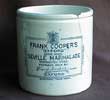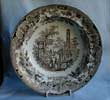
We are not responsible for links to external sites
Maling history1853-c1880 - CT Maling, Keiller's and two new potteriesRobert's son, Christopher Thompson Maling, took over the running of the business in the early 1850s. Although production of domestic wares almost certainly continued, it was CT Maling who was to take the business in a new direction and bring it to international prominence. He had discovered a way to make packaging containers by machine, rather than by hand. Jars for marmalade, meat paste, ointment, printing ink and many other products could be turned out on a huge scale. One of the first and biggest customers were the marmalade manufacturers Keiller's of Dundee. The records show them ordering as many as 1,500,000 jars in a single year. Needless to say, these jars have little value today, but they are found in many parts of the world, as Keiller's had a massive export trade. Cooper's of Oxford were also major customers. By building not one, but two, new potteries within less than 20 years, CT Maling ensured that the company ended up with over 90 per cent of this packaging market. The Ford A pottery, built in 1859 and named after CTM's wife Mary Ford, could produce as much in one week as the Ouseburn Bridge pottery had in a year! The Ford B pottery was built in 1878. It, too, dwarfed its predecessor and was claimed to be the biggest pottery in the world. The two potteries operated in tandem until the 1920s, when the Ford A pottery finally closed as a consequence of the difficulty of obtaining coal during the General Strike. Despite the volume of the packaging business (which would continue to as late a date as the 1930s), it is likely that the production of decorative wares was maintained, using bought-in transfers. The 'Denon's Egypt' plate is an example.
|

